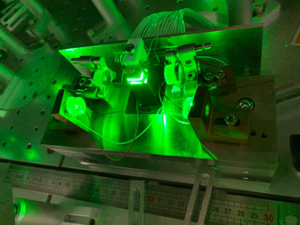Quantum fluctuations of light make Virgo mirrors jitter
A quantum mechanical effect measured for the first time in the Advanced Virgo and LIGO gravitational-wave detectors
Quantum mechanics does not only describe the universe at the scale of atoms and elementary particles, but also affects the motion of macroscopic objects, such as the 42-kg mirrors of the Advanced Virgo interferometer. To detect gravitational waves, the Virgo collaboration (including scientists from the LKB Optomechanics and Quantum Measurement Group) and its US-based equivalent LIGO measure tiny changes in the lengths of their laser interferometer arms, changes as small as one thousandth of a proton diameter. The two detectors use laser light to measure, with the highest precision, the relative position of mirrors that are kilometres apart. For this reason, these mirrors are kept as ‘still’ as possible and are shielded from all possible noises of human or environmental origin. Still, even in the absence of any gravitational-wave signals or noise sources, the mirror position measurements would show a slight jitter, due to the quantum fluctuations of light. In both Virgo and LIGO, during the third observation period (O3, from April 2019 to March 2020), this noise was reduced by ‘squeezing’ the light, using a particular quantum optics technique, which the LKB has contributed developing for over 30 years. Unfortunately, this is not possible to do this without paying a price.
Following Heisenberg’s inequality, reduced quantum fluctuations in the measurement result in increased radiation pressure noise: the force with which the stream of photons pushes on the mirrors now fluctuates more strongly, and as a result, the mirrors move back and forth more despite their mass. It is this particular effect, predicted since the late 70s but only demonstrated on nanomechanical resonators in 2013, that has been demonstrated for the first time with really macroscopic systems. This research has just been published in Physical Review Letters. A similar article has been published by the LIGO collaboration.
To further improve the detector’s performance, Virgo scientists are developing, notably at LKB, a new technology, called frequency-dependent squeezing. In fact, measurement quantum noise affects the sensitivity of the detector at high frequencies, while the radiation-pressure noise only disturbs the detection of signals with lower frequencies. Getting out of this dead-end is not easy because increasing the sensitivity of the detector at high frequencies, and therefore to a certain type of gravitational-wave source, eventually lowers its ability to identify low-frequency signals. But the new squeezed light source will allow to simultaneously reduce both kinds of quantum noise. The implementation of this technique is actually one of the crucial steps of the upgrade of the Advanced Virgo Interferometer, which is currently taking place at the European Gravitational Observatory near Pisa in Italy.

Source of frequency-dependent squeezed light, developed in a collaboration between LKB and IJCLab in Orsay. The squeezed light is first created in the crystal where the green light is focussed. The optical components are used to inject this light into a cavity that adds the proper frequency dependence. (Crédit : P. Gruning – IJCLab – CNRS, Orsay)
Article : https://journals.aps.org/prl/abstract/10.1103/PhysRevLett.125.131101
